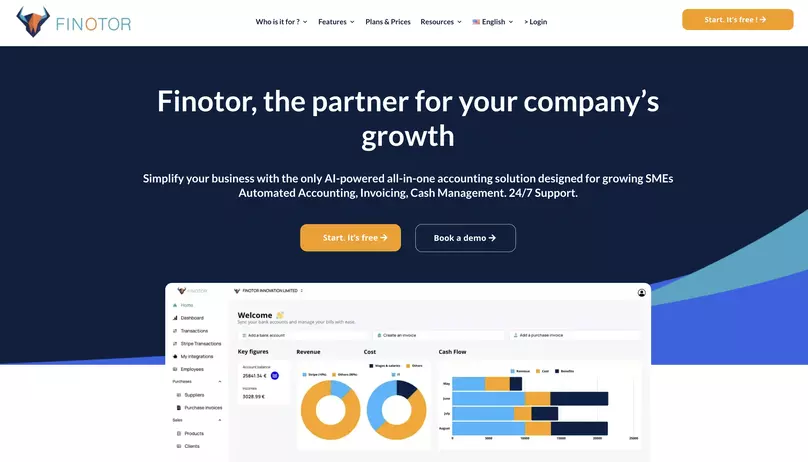Contents
- 1 What is an Inventory?
- 2 Types of Inventory and Inventory Management Objectives
- 3 Benefits and Challenges of Inventory Management
- 4 Inventory Management Strategies
- 5 The foundation of inventory optimization
- 6 Leveraging technology for enhanced inventory control
- 7 Streamlining Supply Chain Management Processes
- 8 Measuring and improving inventory performance
- 9 Types of Inventory Management Software Systems
- 10 Tips for Entrepreneurs on Ecommerce Inventory Management in a Company
- 11 FAQ: Inventory Management in a Company
- 12 References
- 13 Additional Resources
Effective inventory management is crucial for businesses, especially for an ecommerce business, aiming to optimize their operations and boost profitability. As a business advisor with extensive experience in guiding companies towards growth, I’ve witnessed firsthand the impact of well-executed inventory strategies on a company’s bottom line. In 2023, a study by the National Retail Federation revealed that inventory shrinkage cost US retailers $94.5 billion, highlighting the critical need for robust inventory control measures. Let’s delve into some key strategies that can help businesses streamline their inventory processes and maximize their returns.
What is an Inventory?
In the world of business, particularly within the realms of manufacturing, e-commerce, and retail, the concept of inventory plays a pivotal role. In the realm of e-commerce, efficient e commerce inventory management is essential for tracking inventory levels, ensuring timely fulfillment, and making informed business decisions. For entrepreneurs and business owners, understanding what inventory entails is crucial for efficient operations and strategic planning.
Definition
Inventory refers to the comprehensive list of goods and materials that a business holds for the purpose of sale or consumption. This encompasses:
- Raw Materials: Basic components used in manufacturing products.
- Work-in-Progress: Items that are still in the process of being manufactured.
- Finished Goods: Completed products ready for sale to customers.
- Maintenance, Repair, and Operations (MRO) Goods: Supplies consumed in the production process but are not part of the final product (e.g., lubricants, cleaning supplies).
Understanding and analyzing inventory data is crucial for making informed decisions about stock levels and inventory management.
Read too : The inventory of a company in accounting
Importance
The importance of defining inventory can’t be overstated:
- Asset Management: Inventory is a significant asset on the balance sheet. Accurately defining it helps in valuing the company and making informed financial decisions.
- Operational Efficiency: Proper inventory management ensures that stock levels meet customer demand without overstocking, which can tie up capital.
- Customer Satisfaction: Having the right products in stock at the right time enhances customer experience and loyalty.
- Cost Management: Effective inventory tracking helps identify inefficiencies and reduce unnecessary carrying costs.
A well-defined inventory management process is essential for maintaining operational efficiency and meeting customer demands.
Implications for Business
For entrepreneurs and business leaders, clear inventory definitions guide several aspects of business operations:
- Ordering Practices: Understanding what constitutes inventory helps in setting reorder points and managing supply chain relationships.
- Storage Solutions: It informs warehouse management practices to ensure optimal space utilization and quick access.
- Tracking Systems: Investing in inventory management systems that provide real-time data is essential for monitoring stock levels and movement.
Implementing an effective inventory management method, such as FIFO or JIT, can significantly improve inventory control and profitability.
By grasping the nuances of inventory, business leaders can drive growth, optimize operations, and ultimately boost profitability. When integrated with tools like Finotor, inventory management can become a streamlined, efficient process that adds significant value to any enterprise. So, whether you’re a small business owner or a large corporation, investing in inventory management is crucial for sustained success. Furthermore, understanding the various types of inventory and their implications can help businesses make informed decisions about production, pricing, and sales strategies. This not only ensures smooth operations but also helps companies stay competitive in the fast-paced business world.
Types of Inventory and Inventory Management Objectives
Inventory management is a critical aspect of running a successful e-commerce business. There are several types of inventory that businesses need to manage, including raw materials, work-in-progress, and finished goods. Effective inventory management involves setting clear objectives, such as minimizing inventory costs, maximizing customer satisfaction, improving cash flow, reducing waste and excess inventory, and optimizing inventory levels.
To achieve these objectives, businesses need to understand the different types of inventory and their characteristics. For example, raw materials are the components used to produce finished goods, while work-in-progress refers to products that are still in the production process. Finished goods, on the other hand, are the final products that are ready for sale.
By understanding the different types of inventory and their characteristics, businesses can develop effective inventory management strategies that meet their objectives. This includes implementing inventory management techniques such as just-in-time inventory management, economic order quantity analysis, and ABC analysis.
Benefits and Challenges of Inventory Management
Effective inventory management is essential for e-commerce businesses to succeed. The benefits of inventory management include reduced inventory costs, improved customer satisfaction, increased cash flow, reduced waste and excess inventory, and optimized inventory levels. By implementing a dependable inventory management system, businesses can avoid stockouts, overstocking, and inventory inaccuracies, which can lead to lost sales, damaged reputation, and decreased customer satisfaction.
However, inventory management also presents several challenges. Common challenges include managing multiple sales channels, tracking inventory levels, and optimizing inventory levels. Businesses also need to deal with supply chain disruptions, changes in customer demand, and fluctuations in market trends. To overcome these challenges, businesses need to implement effective inventory management strategies and techniques, such as inventory optimization, safety stock management, and demand planning.
Inventory Management Strategies
There are several inventory management strategies that businesses can implement to achieve their objectives. One effective strategy is just-in-time inventory management, which involves ordering and receiving inventory just in time to meet customer demand. This strategy helps businesses avoid overstocking and reduce inventory costs.
Another effective strategy is economic order quantity analysis, which involves calculating the optimal order quantity to minimize inventory costs. This strategy takes into account factors such as demand, lead time, and ordering costs.
ABC analysis is another effective strategy that involves categorizing inventory into three categories based on their value and importance. This strategy helps businesses prioritize their inventory management efforts and allocate resources effectively.
Safety stock management is also an essential strategy that involves maintaining a buffer stock to meet unexpected changes in demand or supply chain disruptions. This strategy helps businesses avoid stockouts and ensure continuous supply of products to customers.
Demand planning is another critical strategy that involves forecasting future demand and adjusting inventory levels accordingly. This strategy helps businesses optimize their inventory levels and avoid overstocking or understocking.
By implementing these inventory management strategies, businesses can achieve their objectives, reduce costs, and improve customer satisfaction.
The foundation of inventory optimization
At the core of effective inventory management lies a deep understanding of your stock and its movement. I’ve found that many businesses struggle with this fundamental aspect, often leading to costly inefficiencies. To build a solid foundation, consider the following steps:
Accurate forecasting is paramount. By analyzing historical data, market trends, and seasonality, you can predict future demand with greater precision. This foresight allows you to maintain optimal stock levels, reducing both stockouts and excess inventory. Effective ecommerce inventory management involves using advanced tools and techniques to optimize stock levels and reduce costs.
Implementing a robust inventory tracking system is equally crucial. Modern technologies like RFID tags and barcode scanners can significantly improve accuracy and efficiency in stock counting and management. During my tenure at Finotor, our AI-powered solution helped clients reduce inventory discrepancies by up to 30%.
Another critical element is categorizing your inventory. The ABC analysis method, which categorizes items based on their value and turnover rate, can be particularly effective. Here’s a breakdown of this approach:
- A items: High-value products with fast turnover
- B items: Moderate value and turnover
- C items: Low-value products with slow turnover
By focusing more attention on A items, you can allocate resources more efficiently and improve overall inventory control.
Leveraging technology for enhanced inventory control
In today’s digital age, leveraging technology is not just an option; it’s a necessity for effective inventory management. As the co-founder of Neotoria, I’ve seen firsthand how technological solutions can revolutionize stock control processes. Here are some key technologies that can significantly improve your inventory management:
Enterprise Resource Planning (ERP) systems offer a comprehensive solution for managing various aspects of your business, including inventory. These systems provide real-time visibility into stock levels, automate reorder processes, and integrate with other business functions like accounting and sales. Technology plays a crucial role in inventory management in e commerce, providing real-time visibility and automation for better control.
Artificial Intelligence (AI) and Machine Learning (ML) are transforming inventory management. These technologies can analyze vast amounts of data to identify patterns, predict demand fluctuations, and optimize stock levels. At Finotor, we’ve developed AI algorithms that have helped businesses reduce inventory costs by up to 25%.
The Internet of Things (IoT) is another game-changer in inventory management. IoT devices can track the location and condition of inventory in real-time, providing valuable insights for decision-making. For instance, IoT sensors can monitor temperature-sensitive goods, ensuring quality control throughout the supply chain.
Here’s a comparison of these technologies and their benefits:
| Technology | Key Benefits | Implementation Complexity |
|---|---|---|
| ERP Systems | Comprehensive integration, Real-time visibility | High |
| AI/ML | Predictive analytics, Demand forecasting | Medium to High |
| IoT | Real-time tracking, Quality control | Medium |
Streamlining Supply Chain Management Processes
Efficient inventory management extends beyond the walls of your warehouse. It encompasses your entire supply chain. As someone who has guided multiple businesses through growth phases, I can attest to the importance of a well-optimized supply chain in maintaining optimal inventory levels.
Just-in-Time (JIT) inventory is a strategy that has gained significant traction in recent years. This approach involves receiving goods only as they are needed in the production process, thereby reducing storage costs and minimizing waste. However, it requires precise coordination with suppliers and a deep understanding of your production cycles. Understanding how to manage inventory effectively is essential for reducing costs and improving supply chain efficiency.
Vendor-managed inventory (VMI) is another effective approach. In this model, suppliers take responsibility for maintaining agreed-upon inventory levels. This can reduce the burden on your team and ensure more consistent stock availability. During my time with Société-France-Irlande, we successfully implemented VMI programs that resulted in a 15% reduction in inventory holding costs for our clients.
Implementing a robust returns management process is often overlooked but crucial for effective inventory control. A streamlined returns process can help you quickly reintegrate returned items into your available stock, reducing waste and improving customer satisfaction. Consider the following steps for an effective returns management strategy :
- Establish clear return policies
- Implement an efficient tracking system for returns
- Train staff on proper handling and processing of returned items
- Analyze return data to identify trends and address recurring issues
By focusing on these supply chain optimizations, you can significantly improve your inventory turnover ratio and reduce carrying costs.
Measuring and improving inventory performance
To truly optimize your inventory management, it’s essential to consistently measure and analyze your performance. Throughout my 15 years of experience in business advisory, I’ve found that companies that regularly assess their inventory metrics are better positioned to identify areas for improvement and implement effective strategies.
Key Performance Indicators (KPIs) play a crucial role in this process. Some essential inventory KPIs to monitor include :
- Inventory turnover ratio
- Days of inventory on hand
- Carrying cost of inventory
- Stock-out rate
- Order fulfillment rate
Regular cycle counting is another vital practice for maintaining accurate inventory records. Rather than conducting annual full inventory counts, which can be disruptive and time-consuming, cycle counting involves regularly counting a small portion of your inventory on a rotating basis. This approach allows for more frequent checks and quicker identification of discrepancies.
Lastly, continuous improvement should be at the heart of your inventory management strategy. Regularly review your processes, seek feedback from staff and customers, and stay informed about industry best practices and technological advancements. By fostering a culture of continuous improvement, you can ensure that your inventory management strategies remain effective and adaptable in an ever-changing business landscape.
Types of Inventory Management Software Systems
Now that we have established what inventory comprises let us delve into some common methods used to manage it. Here are different inventory management:
- FIFO (First-In-First-Out) Method: This method assumes that the first items added to the inventory are the first ones sold. It works well for perishable goods like food or pharmaceuticals.
- LIFO (Last-In-First-Out) Method: This method assumes that the last items added to the inventory are the first ones sold. It is commonly used for non-perishable goods.
- ABC Analysis: A technique for categorizing inventory based on its value and importance, with “A” items being high-value and critical, “B” items being moderate in value and importance, and “C” items being low in value and importance.
- Just-In-Time (JIT): A strategy where materials are ordered and received just in time for production or sale, minimizing storage costs and waste.
Maintaining safety stock inventory is crucial for managing unexpected changes in demand and supply chain delays.
Each of these methods has its own advantages and disadvantages, depending on the type of business and industry. It is essential for businesses to understand their inventory needs and choose a system that best suits their requirements. Additionally, with advancements in technology, there are now sophisticated inventory management software options available that automate and streamline the process.
Overall, inventory management is crucial for any business looking to thrive in today’s competitive market. By understanding its definition, importance, implications, and various systems available, entrepreneurs can make informed decisions and drive growth within their organization. So keep learning more about inventory management to stay ahead of the game!
Overall, maintaining efficient inventory practices is vital for any successful business. By understanding what constitutes as inventory, its significance in operations and decision-making, and the different management systems available, businesses can achieve better control over their resources and improve overall performance.
With the right knowledge and tools, inventory can be a strategic asset that fuels growth and success in any industry. So take the time to learn more about inventory management and implement effective practices within your business today!
Keep exploring topics such as supply chain management, logistics, and lean manufacturing to gain a deeper understanding of how inventory fits into the bigger picture of business operations. Continuously seeking new knowledge and adapting to changes in the market will ensure that your inventory management practices remain efficient and effective for sustained success.
So don’t let your inventory become a burden – embrace it as a valuable asset and watch your business thrive! Happy learning!
Tips for Entrepreneurs on Ecommerce Inventory Management in a Company
- Implement Inventory Management SoftwareInvest in a reliable inventory management system that automates tracking, updates stock levels in real-time, and generates accurate reports. Tools like Finotor can streamline the process, reduce errors, and provide valuable insights. For an ecommerce business, understanding ecommerce inventory is essential for tracking stock levels and ensuring timely fulfillment.
- Track Key MetricsMonitor key metrics such as inventory turnover, reorder points, and days sales of inventory (DSI). These indicators help you understand how quickly stock is sold, when to reorder, and how long inventory stays in storage.
- Use Just-In-Time (JIT) InventoryConsider adopting a Just-In-Time (JIT) inventory system to reduce holding costs. By ordering stock only when it’s needed, you can minimize storage expenses and free up cash flow.
- Balance Stock LevelsFind the right balance between understocking and overstocking. Too much inventory ties up capital, while too little can lead to stockouts and lost sales. Use demand forecasting to avoid these issues.
- First-In, First-Out (FIFO) MethodApply the FIFO method to manage perishable or time-sensitive goods. This ensures that older stock is sold first, reducing the risk of spoilage or obsolescence.
- Regular Inventory AuditsSchedule regular physical inventory audits to verify that the quantities in your system match the actual stock on hand. This helps identify discrepancies early and prevents potential financial issues.
- Set Reorder PointsEstablish clear reorder points for each product to trigger automatic orders when inventory falls below a certain level. This ensures you’re always prepared without overstocking.
- Monitor Supplier PerformanceEvaluate your suppliers regularly to ensure timely deliveries and consistent quality. Delays or inconsistencies from suppliers can disrupt your inventory management and affect sales.
- Leverage Data for ForecastingUse historical sales data and seasonal trends to forecast demand accurately. Proper demand forecasting allows you to anticipate future inventory needs, minimizing excess stock and stockouts.
- Optimize Storage and OrganizationEnsure your storage space is well-organized, labeled, and accessible. A well-structured warehouse or storage area improves efficiency and reduces the risk of misplaced or forgotten items.
Managing inventory effectively ensures that your business runs smoothly, improves cash flow, and leads to long-term growth and profitability. These tips will help you make better decisions about inventory management as an entrepreneur.
FAQ: Inventory Management in a Company
- What is an inventory in a company?Inventory refers to the goods and materials a company holds for the purpose of resale, production, or day-to-day operations. It includes raw materials, work-in-progress, and finished goods.
- Why is inventory management important?Effective inventory management helps companies track stock levels, reduce holding costs, prevent stockouts, and ensure that resources are used efficiently. It optimizes cash flow and keeps operations running smoothly.
- What are the types of inventory?There are generally three types of inventory: raw materials (used in production), work-in-progress (partially completed goods), and finished goods (ready for sale).
- How do companies track their inventory?Companies use various inventory management systems, including manual methods, spreadsheets, or advanced software like Finotor that automates tracking, reordering, and reporting in real-time.
- What is the best method for inventory management?The best method depends on the business size and type, but popular approaches include First-In, First-Out (FIFO), Last-In, First-Out (LIFO), and Just-In-Time (JIT) inventory management.
- How does poor inventory management affect a business?Poor inventory management can lead to stockouts, excess inventory, high holding costs, and lost sales, which negatively affect cash flow and profitability.
- What are the key metrics for inventory management?Key metrics include inventory turnover ratio, days sales of inventory (DSI), stock-to-sales ratio, and reorder point, which help businesses understand stock levels, demand, and efficiency.
- How does inventory management software help?Inventory management software, such as Finotor, automates tracking, updates stock levels in real-time, generates reports, and helps businesses optimize ordering processes, reducing human errors and saving time.
- What is the difference between perpetual and periodic inventory systems?A perpetual inventory system continuously updates inventory records with each transaction, while a periodic system updates inventory levels at specific intervals, such as monthly or quarterly.
- How can a company optimize its inventory levels?A company can optimize inventory by analyzing demand patterns, using accurate forecasting, implementing inventory management software, and maintaining a balance between stock availability and holding costs.
- What are some common ecommerce inventory management FAQs?Common FAQs include how to track inventory levels, manage stockouts, and optimize inventory for online sales.
References
- Investopedia. (2021). FIFO vs. LIFO: What’s the Difference? Retrieved from https://www.investopedia.com/terms/f/fifo.asp
- Business Queensland. (2019). Inventory management systems. Retrieved from https://www.business.qld.gov.au/running-business/employing/managing-inventory/systems-introduction/types
- Finotor. (n.d.). Overview of inventory management systems and techniques. Retrieved from https://finotor.com/inventory-management-systems/
- Forbes Councils Member. (2018). The Importance of Inventory Management for Small Businesses – And How to Get It Right. Retrieved from https://www.forbes.com/sites/forbesbusinesscouncil/2018/08/29/the-importance-of-inventory-management-for-small-businesses-and-how-to-get-it-right/?sh=6324fd7d6c75
Note: These references are for further reading and do not necessarily reflect the views of Finotor or its affiliates.
Additional Resources
- Inventory Management Best Practices
- 5 Inventory Management Tips for Small Businesses
- The Role of Technology in Inventory Management
- Effective Inventory Management Strategies for E-commerce Businesses
Keep learning and stay ahead of the game with these additional resources on inventory management! Happy managing! :bar_chart: :rocket:
This document is for informational purposes only and should not be construed as financial or legal advice. Please consult with a professional before making any business decisions.
- 5 Inventory Management Tips for Small Businesses









